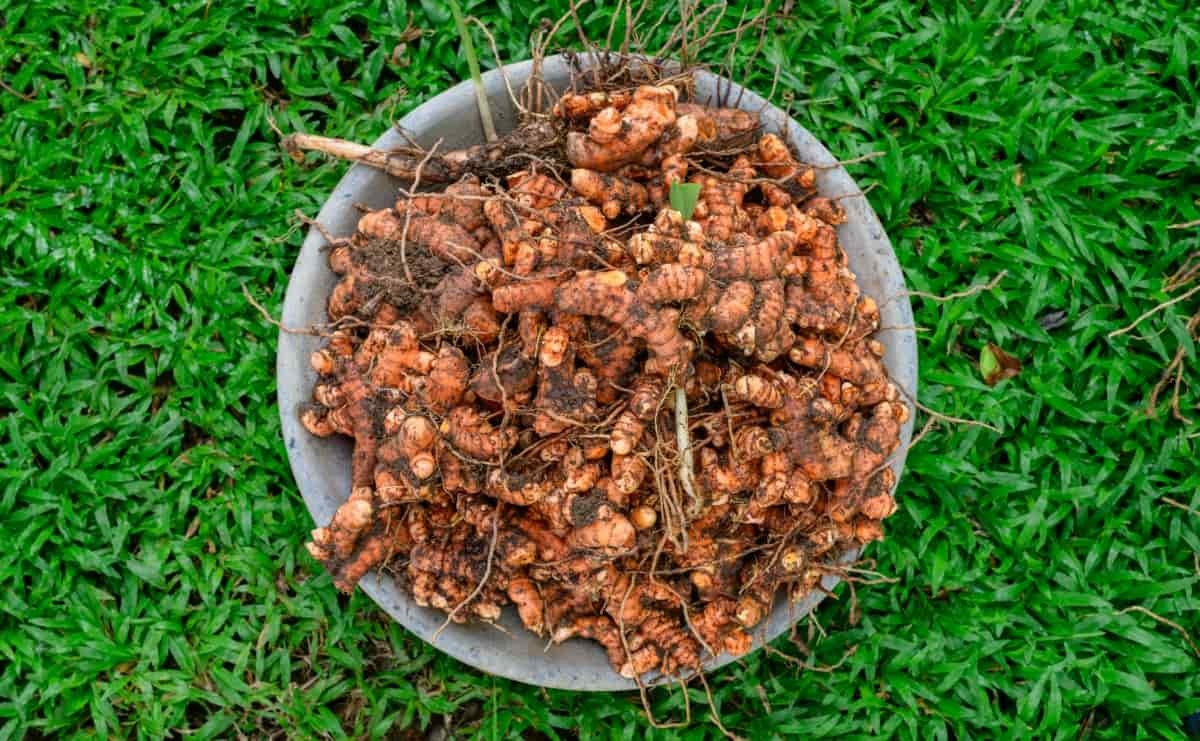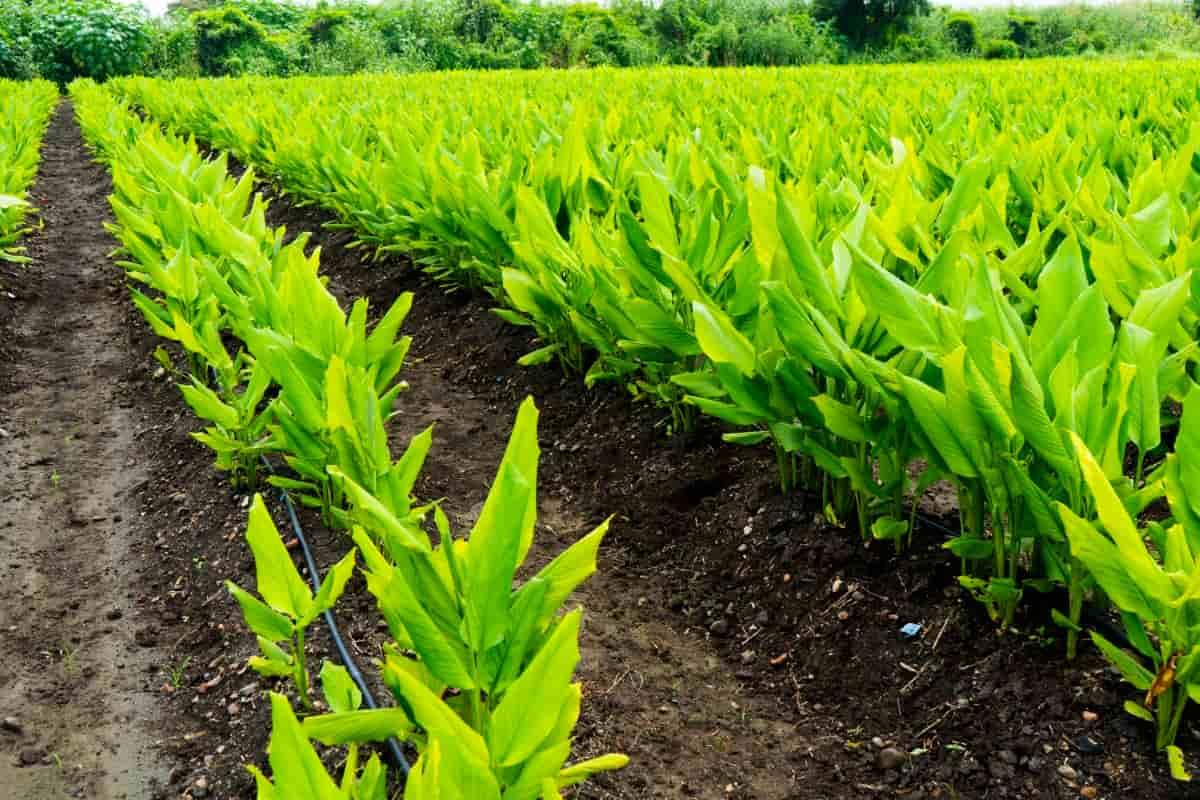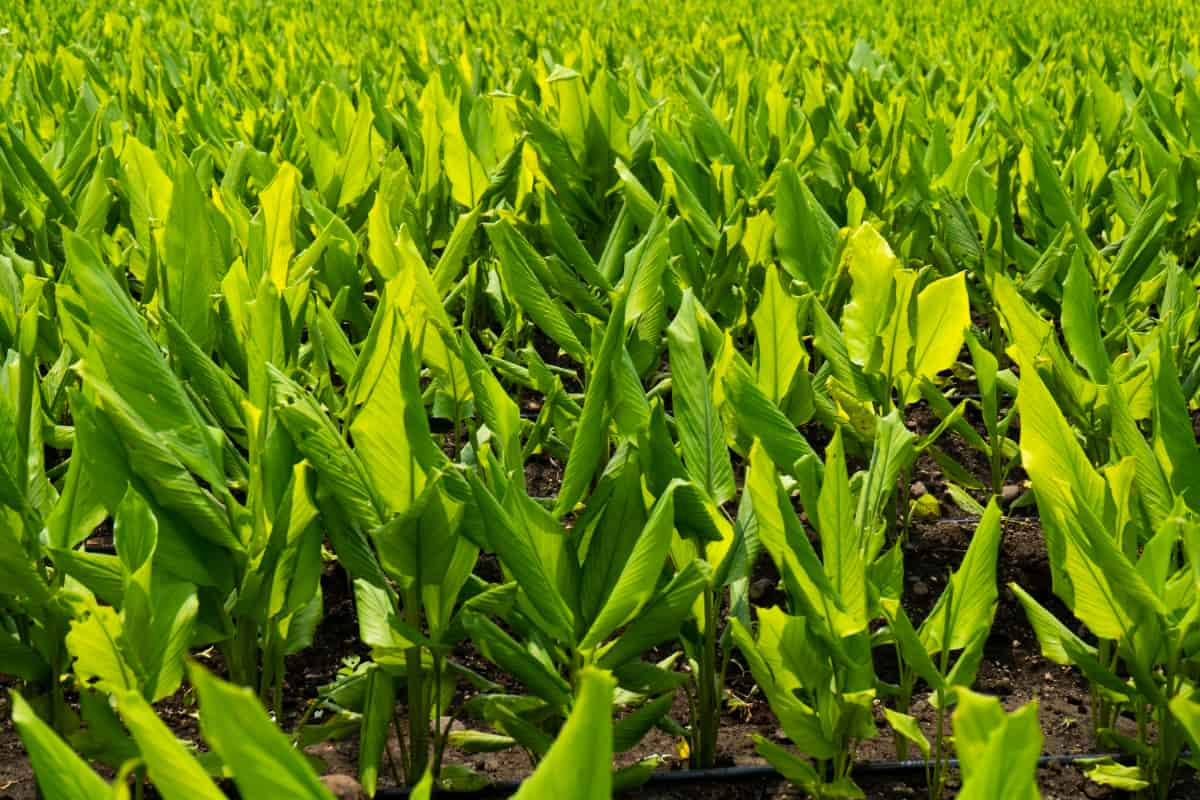Welcome to our blog on Turmeric Fertilizer Requirements and Recommendations – your ultimate guide to maximizing yields and enhancing the health of your turmeric plants! Whether you’re a seasoned farmer or an enthusiastic gardener, understanding the right fertilizer practices is essential for achieving a successful harvest. This comprehensive blog includes the essential nutrients turmeric craves and the ideal application methods. We’ve covered you, from nitrogen to potassium ratios to micronutrient needs.

Turmeric Fertilizer Requirements
Turmeric Manuring and Fertilizer Application
Farmyard Manure (FYM) and Compost: Farmyard manure or compost serves as a vital organic source of nutrients for turmeric plants. A recommended dosage of 30-40 tonnes per hectare is applied by broadcasting and plowing during land preparation. Alternatively, it can be used as a basal dressing by spreading over beds or pits during planting. Organic matter enriches the soil, promotes beneficial microbial activity, and enhances plant health.
Chemical Fertilizer Application: To supplement the nutrient requirements of turmeric, chemical fertilizers should be applied in split doses. The recommended dosage per hectare includes 60 kg of nitrogen (N), 50 kg of phosphorus (P2O5), and 120 kg of potassium (K2O). These should be applied in a schedule, as outlined below:
- Basal application: 50 kg of P2O5 per hectare.
- After 45 days: 30 kg of N and 60 kg of K2O per hectare.
- After 90 days: 30 kg of N and 60 kg of K2O per hectare.
Zinc and Organic Manures: Zinc is an essential micronutrient for turmeric plants. Applying 5 kg of zinc per hectare during planting ensures healthy growth and development. Organic manures such as oil cakes can be integrated into the fertilizer regimen at 2 tonnes per hectare. When organic manures are used, the dosage of FYM can be adjusted accordingly.
Integrated Fertilizer Application: An effective integrated approach involves combining coir compost, FYM, biofertilizer (Azospirillum), and half the recommended dose of NPK. Coir compost, at a rate of 2.5 tonnes per hectare, when used alongside other organic and inorganic fertilizers, promotes soil structure, water retention, and nutrient availability for turmeric plants.
Mulching for Enhanced Performance: Mulching plays a crucial role in conserving soil moisture, suppressing weed growth, and maintaining an optimum temperature for turmeric. Immediately after planting, mulching with green leaves at a rate of 12-15 tonnes per hectare is recommended. Subsequently, repeat mulching at 45 and 90 days after planting, following weeding, fertilizer application, and earthing up, using 7.5 tonnes per hectare.
In case you missed it: Top 20 Steps to Boost Turmeric Yield: How to Increase Production, Quality, Size, Methods, and Tips

Organic Turmeric Fertilizer Requirements
Compost and Farmyard Manure (FYM): Organic turmeric cultivation relies on the rich nutrients of compost and FYM. A recommended dosage of 30-40 tonnes per hectare of FYM or compost is applied during land preparation. These organic sources enhance soil structure, improve water retention, and foster beneficial microbial activity.
Organic Nitrogen Sources: Nitrogen is vital for turmeric growth, and various organic sources can fulfill this need. Incorporating leguminous cover crops or green manure can contribute major amounts of nitrogen to the soil. Biofertilizers like Azospirillum and Azotobacter also play a key role in fixing atmospheric nitrogen and making it available to turmeric plants.
Phosphorus from Organic Materials: Phosphorus is essential for root development and plant growth. Organic materials like bone meal and rock phosphate can supply phosphorus to the turmeric crop. These natural sources gradually release phosphorus, ensuring a steady supply throughout the plant’s growth.
Potassium Enrichment with Organic Choices: Organic potassium sources like wood ash, potassium sulfate, and kelp meal effectively provide this essential nutrient to turmeric plants. Potassium needed for flower bud and fruit development, and organic choices contribute to a balanced nutrient intake.
Micronutrients from Organic Amendments: Besides major nutrients, micronutrients are equally important for turmeric health. Organic amendments like seaweed extracts, fish emulsion, and composted manure can supply micronutrients such as zinc, iron, copper, and manganese, promoting plant vigor.
Best Fertilizer for Turmeric Plants
- Neem Cake Fertilizer: Neem cake is a natural organic fertilizer with nitrogen, phosphorus, and potassium. It enhances soil fertility and is a natural pest repellent, promoting healthy turmeric growth.
- Fish Emulsion Fertilizer: Fish emulsion provides a balanced nutrient mix, including nitrogen, phosphorus, and trace minerals. It fosters vigorous foliage and flower development in turmeric plants.
- Seaweed Extract Fertilizer: Seaweed extract is a rich source of micronutrients, growth hormones, and beneficial plant compounds. It enhances turmeric plant resilience and boosts overall nutrient uptake.
- Vermicompost Fertilizer: Vermicompost is a nutrient-dense organic fertilizer produced by earthworms. It enriches the soil with essential nutrients and improves its structure, leading to healthy turmeric growth.
- Bone Meal Fertilizer: Bone meal is high in phosphorus, ideal for promoting strong root development and flower formation in turmeric plants.
- Wood Ash Fertilizer: Wood ash is a natural source of potassium and trace minerals. Maintain the pH of the soil and supports robust turmeric growth.
- Kelp Meal Fertilizer: Kelp meal supplies a range of nutrients, including potassium, trace minerals, and growth-promoting hormones. It enhances overall plant health and yield.
- Cow Manure Fertilizer: Cow manure is a traditional organic fertilizer provide nitrogen and other nutrients. It improves soil structure and enhances turmeric plant vigor.
In case you missed it: Organic Turmeric Cultivation in Polyhouse (Haldi Farming)

Turmeric Plant Nutrient Needs
Nitrogen (N): Nitrogen is essential for promoting lush, leafy growth in turmeric plants. It stimulates the production of chlorophyll and enzymes, facilitating photosynthesis and energy transfer within the plant. However, excessive nitrogen can lead to vegetative dominance and delay flowering, negatively impacting yield.
Phosphorus (P): Phosphorus is vital for root development, early growth, and the formation of flowers and fruits. It aids energy storage and transfer, enhancing overall plant vigor and productivity.
Potassium (K): Potassium contributes to numerous physiological processes, including enzyme activation and water uptake. It improves the plant’s resistance to stress and disease, ensuring a robust and healthy turmeric crop.
NPK Ratios for Turmeric: Striking the right balance between these nutrients is crucial. For example, Fertilizers 60 kg N, 50 kg P2O5, and 120 kg K2O per hectare will be applied in split doses. A commonly recommended NPK ratio for turmeric is 1:0.5:1.5, indicating that the ideal fertilizer should contain one part nitrogen, 0.5 parts phosphorus, and 1.5 parts potassium.
Nitrogen Requirements for Turmeric Cultivation
Nitrogen is crucial for turmeric plants’ leafy growth, protein synthesis, and chlorophyll production. A balanced approach is necessary, with split doses for optimal uptake. The basal application supports early growth during land preparation. Timely application of additional nitrogen doses is recommended to meet plant growth stages. Regular monitoring and adjustment of nitrogen application based on observed growth and soil test results ensures optimal results.
Phosphorus Fertilization in Turmeric Farming
Phosphorus is crucial for turmeric farming, particularly during the early stages, as it promotes robust root development and overall plant health. Rock phosphate and bone meal are excellent natural sources of phosphorus, providing a steady supply. Applying phosphorus-rich fertilizers during planting or as basal dressing ensures young turmeric plants receive the necessary nutrients for healthy root establishment.
The recommended dosage depends on soil conditions and nutrient content, and it is best to split the application into two or more doses for balanced uptake. Avoid overuse, as excessive phosphorus can lead to nutrient imbalances and environmental issues. Always follow the recommended guidelines for responsible and effective phosphorus fertilization in turmeric farming.
Potassium Recommendations for Turmeric Crops
Potassium is a crucial nutrient for healthy turmeric crops, enhancing plant vigor and disease resistance. To ensure optimal growth and yields, potassium needs to be met effectively. Best fertilizers for potassium supply include potassium sulfate (SOP) and muriate of potash (MOP). Applying potassium fertilizers evenly across the field and using split doses is beneficial.
In case you missed it: Turmeric Cultivation Income, Project Report, Yield, Profits

Applying potassium during specific growth stages, including land preparation and planting, ensures continuous nutrient availability. Foliar application can help address severe potassium deficiency. Maintaining an appropriate soil pH (6.0 to 7.5) is crucial for potassium availability. A balanced nutrition approach with nitrogen, phosphorus, and potassium for overall plant health and good yield.
Micronutrient Requirements of Turmeric Plants
Turmeric plants require various micronutrients for healthy growth and development, including zinc, iron, copper, manganese, and boron. Zinc aids in enzyme activation and protein synthesis, while iron is vital for chlorophyll production. Copper plays a role in biochemical processes, and manganese contributes to photosynthesis. Boron for cell wall formation and reproductive development. Specific fertilizers such as zinc sulfate or zinc chelates, ferrous sulfate or iron chelates, copper sulfate or copper chelates, manganese sulfate, and boric acid or borax can be applied.
Application methods include foil application, soil application during land preparation, and regular soil testing to identify potential deficiencies. Preventing micronutrient deficiencies involves maintaining soil pH within the optimal range (6.0 to 7.5), incorporating organic matter, and ensuring proper soil testing for optimal plant health.
Soil pH for Turmeric Cultivation
Turmeric is a crop flourishing in different tropical conditions. It can be cultivated from sea level to 1500 m above sea level, at temperatures between 20-35°C, with rainfall of 1500 mm or more, under rainfed or irrigated conditions. This adaptability extends to different soil types, although turmeric thrives in well-drained sandy or clay loam soils. The ideal soil pH range for turmeric cultivation lies between 4.5 to 7.5, encompassing slightly acidic to neutral conditions. Additionally, turmeric plants perform best when the soil has good organic content.
Fertilizer Application Rates for Turmeric Farming
Fertilizer application rates for turmeric farming for providing nutrients at each growth stage, ensuring robust plant development and maximum yields. Apply well-rotted farmyard manure (FYM) or compost at 30-40 tonnes per hectare during land preparation. A balanced NPK fertilizer should be used in split doses as the crop grows. Basal application should include 50 kg of P2O5 per hectare.
In case you missed it: Turmeric Cultivation in Polyhouse (Haldee) for Profit

After 45 days, apply 30 kg of nitrogen (N) and 60 kg of potassium (K2O) per hectare. At 90 days, repeat the same dosage. Zinc, an essential micronutrient, can be added at planting (5 kg per hectare). Organic manures like oil cakes can also be integrated at 2 tonnes per hectare. Adjust FYM dosage when using organic options.
Timing of Fertilizer Application in Turmeric Cultivation
- Basal Application: During land preparation, apply a balanced NPK fertilizer as the basal dose. This provides essential nutrients for early root development and initial plant growth.
- First Top Dressing: Around 30-45 days after planting, apply a second dose of nitrogen and potassium to support vegetative growth and enhance leafy development.
- Second Top Dressing: At 60-75 days after planting, apply a third dose of nitrogen and potassium to bolster plant growth and promote healthy rhizome formation.
- Foliar Feeding (Optional): If nutrient deficiencies occur, a foliar spray of micronutrients can be applied during the active growth phase.
Foliar Feeding of Turmeric Plants
Foliar feeding is a technique for providing essential nutrients to turmeric plants through their leaves. A balanced liquid fertilizer with nitrogen, phosphorus, potassium, and micronutrients is ideal for foliar-feeding turmeric. It promotes plant health and is most effective during the early morning or late afternoon when stomata are open.
Applying the fertilizer during the vegetative stage and before flowering boosts plant vigor and supports flower and rhizome development. The foliar feeding schedule involves diluting the fertilizer, applying the solution using a spray pump, performing foliar feeding every 15 days during the vegetative stage, and reducing frequency during flowering and rhizome formation.
Nutrient Deficiencies in Turmeric Plants
Nitrogen Deficiency: Symptoms include yellowing of older leaves and stunted growth. Nitrogen is crucial for leafy development and overall plant vigor. Apply nitrogen-rich organic or inorganic fertilizers to address the deficiency.
Phosphorus Deficiency: Manifests as purplish discoloration on leaves and poor root growth. Phosphorus supports root development and flowering. Incorporate phosphorus-rich fertilizers during planting to rectify the deficiency.
Potassium Deficiency: Leads to burnt leaf edges and weak stems. Potassium enhances disease resistance and plant strength. Apply potassium fertilizers in split doses to restore plant health.
Micronutrient Deficiencies: Include zinc, iron, copper, and manganese. These lead to various growth abnormalities. Apply micronutrient supplements to ensure proper enzymatic activity and photosynthesis in turmeric plants.
Sustainable Fertilization Practices for Turmeric Cultivation
- Organic Fertilizers: Replace synthetic fertilizers with organic alternatives like compost, farmyard manure, and green manure. These enrich the soil with nutrients, improve soil structure, and foster beneficial microbial activity.
- Crop Rotation: Rotate turmeric with different crops to break pest and disease cycles, reduce soil nutrient depletion, and promote balanced nutrient uptake.
- Cover Cropping: Plant cover crops between turmeric cycles to prevent soil erosion, fix nitrogen, and naturally enhance soil fertility.
- Mulching: Apply mulch to save soil moisture, suppress weeds, and gradually release nutrients to the turmeric plants.
- Biofertilizers: Utilize beneficial microorganisms like Azospirillum and Azotobacter to fix atmospheric nitrogen and enhance nutrient availability.
- Green Manure: Grow leguminous cover crops and incorporate them into the soil to increase nitrogen content and boost soil health.
- Soil Testing: Regularly test the soil to assess nutrient levels and tailor fertilizer application to the specific needs of the turmeric crop.
- Integrated Nutrient Management: Combine organic and inorganic fertilizers judiciously to optimize nutrient uptake while minimizing environmental impacts.
In case you missed it: Turmeric Diseases, Pests, Symptoms, Control Measures

Conclusion
Understanding turmeric fertilizer requirements is essential for successful cultivation. Balancing organic and inorganic sources while considering specific nutrient needs ensures healthy growth, higher yields, and sustainable farming practices.
- Types of Pesticides Used in Agriculture: A Beginner’s Guide
- Economical Aquaculture: A Guide to Low-Budget Fish Farming
- 15 Common Planting Errors That Can Doom Your Fruit Trees
- How to Make Houseplants Bushy: Effective Tips and Ideas
- Innovative Strategies for Boosting Coconut Pollination and Yield
- Pollination Strategies for Maximum Pumpkin Yield
- The Complete Guide to Chicken Fattening: Strategies for Maximum Growth
- Natural Solutions for Tulip Problems: 100% Effective Remedies for Leaf and Bulb-Related Issues
- Revolutionizing Citrus Preservation: Towards a Healthier, Greener Future
- Natural Solutions for Peony Leaf and Flower Problems: 100% Effective Remedies
- Maximizing Profits with Avocado Contract Farming in India: A Comprehensive Guide
- Natural Solutions for Hydrangea Problems: 100% Effective Remedies for Leaf and Flowers
- The Ultimate Guide to Choosing the Perfect Foliage Friend: Bringing Life Indoors
- From Sunlight to Sustainability: 15 Ways to Use Solar Technology in Agriculture
- The Ultimate Guide to Dong Tao Chicken: Exploring from History to Raising
- The Eco-Friendly Makeover: How to Convert Your Unused Swimming Pool into a Fish Pond
- Mastering the Art of Delaware Chicken Farming: Essentials for Healthy Backyard Flocks
- 20 Best Homemade Fertilizers for Money Plant: DIY Recipes and Application Methods
- How to Craft a Comprehensive Free-Range Chicken Farming Business Plan
- Brighten Your Flock: Raising Easter Egger Chickens for Beauty and Bounty
- How to Optimize Your Poultry Egg Farm Business Plan with These Strategies
- Subsidy for Spirulina Cultivation: How Indian Government Schemes Encouraging Spirulina Farmers
- Ultimate Guide to Raising Dominique Chickens: Breeding, Feeding, Egg-Production, and Care
- Mastering the Art of Raising Jersey Giant Chickens: Care, Feeding, and More
- Ultimate Guide to Raising Legbar Chickens: Breeding, Farming Practices, Diet, Egg-Production
- How to Raise Welsummer Chickens: A Comprehensive Guide for Beginners
- How to Protect Indoor Plants in Winter: A Comprehensive Guide
- Ultimate Guide to Grow Bag Gardening: Tips, Tricks, and Planting Ideas for Urban Gardeners
- Guide to Lotus Cultivation: How to Propagate, Plant, Grow, Care, Cost, and Profit
- Agriculture Drone Subsidy Scheme: Government Kisan Subsidy, License, and How to Apply Online
- Ultimate Guide to Raising Araucana Chickens: Breed Profile, Farming Economics, Diet, and Care
- Bringing Hydroponics to Classroom: Importance, Benefits of Learning for School Students
- Ultimate Guide to Raising Polish Chickens: Breed Profile, Farming Economics, Diet, and Care
- Ultimate Guide to Raising Australorp Chickens: Profile, Farming Economics, Egg Production, Diet, and Care
- Silkie Chicken Farming: Raising Practices, Varieties, Egg Production, Diet, and Care
- Sussex Chicken Farming: Raising Practices, Varieties, Egg Production, Diet and Care